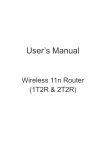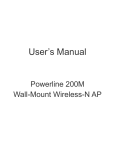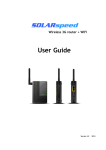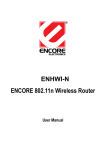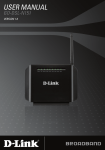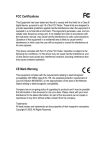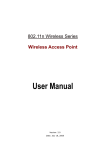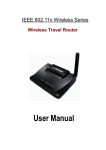Download Longshine LCS-WR5-3214N Wi-Fi Ethernet LAN router
Transcript
802.11n Wireless Series Wireless Broadband Router User Manual Version: 2.0 Date: November 10, 2008 FCC Certifications Federal Communication Commission Interference Statement This equipment has been tested and found to comply with the limits for a Class B digital device, pursuant to Part 15 of the FCC Rules. These limits are designed to provide reasonable protection against harmful interference in a residential installation. This equipment generates, uses and can radiate radio frequency energy and, if not installed and used in accordance with the instructions, may cause harmful interference to radio communications. However, there is no guarantee that interference will not occur in a particular installation. If this equipment does cause harmful interference to radio or television reception, which can be determined by turning the equipment off and on, the user is encouraged to try to correct the interference by one of the following measures: -Reorient or relocate the receiving antenna. -Increase the separation between the equipment and receiver. -Connect the equipment into an outlet on a circuit different from that to which the receiver is connected. -Consult the dealer or an experienced radio/TV technician for help. This device complies with Part 15 of the FCC Rules. Operation is subject to the following two conditions: (1) This device may not cause harmful interference, and (2) this device must accept any interference received, including interference that may cause undesired operation. FCC Caution: Any changes or modifications not expressly approved by the party responsible for compliance could void the user's authority to operate this equipment. IMPORTANT NOTE: FCC Radiation Exposure Statement: This equipment complies with FCC radiation exposure limits set forth for an uncontrolled environment. This equipment should be installed and operated with minimum distance 20cm between the radiator & your body. This transmitter must not be co-located or operating in conjunction with any other antenna or transmitter. November 10, 2008 / Version: 2.0 ii CE Mark Warning This equipment complies with the requirements relating to electromagnetic compatibility, EN 55022 class B for ITE, the essential protection requirement of Council Directive 89/336/EEC on the approximation of the laws of the Member States relating to electromagnetic compatibility. Company has an on-going policy of upgrading its products and it may be possible that information in this document is not up-to-date. Please check with your local distributors for the latest information. No part of this document can be copied or reproduced in any form without written consent from the company. Trademarks: All trade names and trademarks are the properties of their respective companies. Copyright © 2008, All Rights Reserved. 經型式認證合格之低功率射頻電機,非經許可,公司、商號或使用者均不得擅自變更頻率、 加大功率或變更原設計之特性及功能。 低功率射頻電機之使用不得影響飛航安全及干擾合法通信;經發現有干擾現象時,應立即停 用,並改善至無干擾時方得繼續使用。前項合法通信,指依電信法規定作業之無線電通信。 低功率射頻電機須忍受合法通信或工業、科學及醫療用電波輻射性電機設備之干擾。 November 10, 2008 / Version: 2.0 iii Table of Contents UNPACKING INFORMATION ···························································································· 1 INTRODUCTION TO WIRELESS ROUTER······································································· 1 General Description ····································································································· 1 Key Features ··············································································································· 3 The Front Panel ··········································································································· 4 The Rear Panel ··········································································································· 5 Placement (Optional) ··································································································· 5 INSTALLING AND USING WIRELESS ROUTER ······························································ 6 Connecting this Router to your network······································································· 6 Configuring the IP address of your computer ······························································ 6 MANAGEMENT················································································································ 10 Starting the WEB-Based Management Interface ······················································· 10 The Graphic User Interface ························································································11 Operation Mode ········································································································· 12 Network Setting ········································································································· 12 WAN Interface Setup ·························································································· 12 LAN Interface Setup ··························································································· 20 QoS Settings ······································································································ 22 Wireless Settings ······································································································· 23 Basic Settings····································································································· 23 Advanced Settings······························································································ 25 Security Settings································································································· 28 WDS Settings ····································································································· 32 WPS Settings ····································································································· 34 Access Control ··································································································· 36 Firewall Settings ········································································································ 38 IP / Port Filter······································································································ 38 MAC Filter ·········································································································· 40 Layer7 Filter ······································································································· 41 Virtual Server······································································································ 42 Virtual DMZ········································································································· 43 DoS Protection ··································································································· 44 Services Settings ······································································································· 45 DDNS Settings ··································································································· 45 Date/Time Settings ····························································································· 46 Management·············································································································· 47 Admin Account···································································································· 47 November 10, 2008 / Version: 2.0 iv Config ················································································································· 47 Firmware Upgrade······························································································ 48 Information················································································································· 49 System Information····························································································· 49 Packet Statistics ································································································· 50 System Log ········································································································ 50 Logout························································································································ 51 Logout ················································································································ 51 Reboot················································································································ 51 PRODUCT SPECIFICATIONS ························································································· 52 November 10, 2008 / Version: 2.0 v Unpacking Information Thank you for purchasing the product. Before you start, please check all the contents of this package. The product package should include the following: 1. 2. 3. 4. 5. One Wireless Router One power adapter One Quick Installation Guide One User Manual (CD) Three antennas Introduction to Wireless Router General Description The IEEE802.11n Wireless Router is compatible with IEEE802.11n draft 2.0 standard, which supports data rate up to 300 Mbps in 2.4 GHz band, which is also compatible with IEEE 802.11b/g wireless devices. The router allows multiple users to share one broadband connection, as well as secures your private network. With its built-in 4-port switch and wireless AP, LAN users can share files, printers, or playing network games all at a blazing speed. To provide a secure wireless network, this router supports wireless data encryption with 64/128-bit WEP, WPA and WPA2. Network Address Translation (NAT) Firewall is also support to shield your communications and network from hackers and wireless eavesdroppers. The Wireless Router built-in with 4-port 10/100Mbps Fast Ethernet Switch is the latest generation of Wireless router product for Home/Office and SOHO users. This full-feature and self-contained compact Wireless Router will be fully for broadband access in both of LAN and Wireless environment. This device has been specifically designed to provide LAN and Wireless users the most cost-effective method with multiple accesses to the Internet at the cost of a single public IP address(IP Sharing) and enjoy the true Plug-and-Play installation. Moreover, the built-in 4-port 10/100Mbps switch lets users plug the network cable into the device without buying additional switch. This device is also an Access Point. It has a built-in wireless LAN. Users can connect to Internet using wireless network interfaces anywhere within the range of its radio transmission. It’s ideal for SOHO users who require instant and convenient access to November 10, 2008 / Version: 2.0 1 Internet without the restriction of connecting cables. November 10, 2008 / Version: 2.0 2 Key Features The switch provides the following key features: Compatible with IEEE 802.11n draft 2.0, 802.11b/g wireless standards Provides three 802.11n/b/g wireless Reverse SMA antennas High speed transfer data rate up to 300Mbps Supports wireless data encryption with 64/128-bit WEP, WPA and WPA2 Supports authentication for wireless connectivity based on ESSID Supports multiple BSSID. Provides hidden SSID function WDS supported with WEP, TKIP and AES encryption Channel: USA 11, Europe 13 Supports NAT / IP sharing Supports WAN connection type-Static IP, DHCP client, PPPoE and PPTP Firewall; Virtual DMZ; DNS relay; UPnP Provides DHCP server Supports DDNS (DynDNS, TZO) Supports firmware upgrade function via Web Supports system log Certifications: FCC Class B, CE Mark November 10, 2008 / Version: 2.0 3 The Front Panel The front panel of the Wireless Router: LEDs Definitions Status LED The LED will be dark for a few seconds when the system is started. After that, the LED will blink periodically to show the Wireless Router is working normally. If the LED stays green/dark that means the system failed, you need to contact your agent or try to reboot the system. WLAN LED When Wireless Router is ready for data transmitting and receiving, it is steady green. LAN LEDs Every port has an Act/Link LED. Steady green (link state) indicates that the port has good linkage to its associated devices. Flashing green indicates that the port is receiving or transmitting data between its associated devices. WAN LED The LED stays light (green) means the WAN port has good linkage to its associated devices. The LED will blink green when there is traffic transverse the port. EZsetup Button 1 EZsetup button helps out users to connect this Router to Internet quickly. It uses Push Button Communication (PBC) method, in which users can simply push this button to easy setup WPS connection. Please refer to WPS settings for more information. 1 This button may not supplied depend on your model. Users can select the PBC mode in the WPS settings web page to reach the same function. November 10, 2008 / Version: 2.0 4 The Rear Panel The rear panel of the Wireless Router is shown below. Power Connection Plug the circle end of the power adapter firmly into the rear panel of the Wireless Router, and the other end put into an electric service outlet then the system is ready. Restore Default Button 1. Push the button for more than 5 seconds and then release it, the system will return to factory default setting. In the meantime, system rewrites flash to default value and Status LED halts for a while. Approximately 60 seconds later, the Status LED blinks green periodically, now the whole system parameters have returned to factory default value. If the process has been interrupted by any reason (power off…), the system will fail. Before performing the process, ensure a safe operating environment please! 2. To reboot the Router, press the button for 2-5 seconds and then release it, and all the setting won’t be erased. Wait for the Router to complete the reboot, and then you can start to use it. Warning:Incomplete factory setting recovery procedure will cause the Wireless Router malfunction!If you are unfortunately in this situation, do not try to repair it by yourself. Consult your local distributor for help! Placement (Optional) There are three ways to place the Router. The first way is to place the Router vertically on a surface. The second way is to attach it to a magnetic surface. The third way is to attach it to the wall. If you select a wall-mount option, please follow the steps below: 1. Select a location with access for cables and a power outlet. 2. Unplug the unit. Place it upside down on a flat surface and mark the two holes for anchors. 3. Installing the wall mount anchor (not supplied) into the wall with tools such as drill or hammer. 4. Insert the screws (not supplied) in each hole of the stand parts. November 10, 2008 / Version: 2.0 5 5. Attaches the unit to the anchors on the wall. Installing and Using Wireless Router This chapter provides a step-by-step guide to the installation and configuration of the Wireless Router. We suggest you go over the whole chapter and then do more advanced operation. Connecting this Router to your network Steps to build up the network: Connect the ADSL or Cable modem to the Ethernet WAN port on the back of the Wireless Router by using the UTP cable. Connect the phone line from the wall socket to the line-in port on the ADSL modem, or the coaxial cable to the line-in port on the Cable modem. Plug-in the power adapter to the modem and turn on the power. Install the Ethernet card into the computer by referring to the User Guide that came with the card. Connect the computer to the Wireless Router by using standard twisted-pair Ethernet cable from the computer’s Ethernet card to a 10/100Mbps Ethernet port on the back of the Wireless Router. Plug-in the power adapter to the Router and the other side to the wall outlet. Configuring the IP address of your computer In order to communicate with this Wireless Router, you have to configure the IP addresses of your computer to make it compatible with the device. The router supports DHCP server and it is enabled as default. Users that configure your IP address as “Obtain an IP address automatically” may skip the following IP configuration instruction. Note: 1. The default network setting of the device: IP address: Subnet Mask: DHCP Server: 192.168.1.1 255.255.255.0 enable 2. In the following TCP/IP configuration guide, the IP address “192.168.1.2” is assumed to be your IP address if you want to specify IP addresses manually. Please DO NOT choose “192.168.1.1” as the IP address. For the IP address “192.168.1.1“has been set as the default IP for this device. 3. The following TCP/IP configuration guide uses windows XP as the presumed November 10, 2008 / Version: 2.0 6 operation system. November 10, 2008 / Version: 2.0 7 Procedures to configure IP addresses for your computer 1. If you are in Classic Start menu view, click Start > Settings > Control Panel > Network Connections. If you are in Start menu view, click Start > Control Panel > Network Connections. 2. Right-click on Local Area Connection item and double-click on Properties. November 10, 2008 / Version: 2.0 8 3. Choose Internet Protocol (TCP/IP) and click Properties. 4. You may choose “Obtain an IP address automatically” (recommend) to get IP address automatically or choose “Use the following IP address” to specify IP addresses manually. Please click the OK button after your configuration. November 10, 2008 / Version: 2.0 9 Management Starting the WEB-Based Management Interface The device uses WEB as the management interface. You can use a browser to access the management interface easily. Please follow the steps listed below. 1. Double click the Internet WEB browser icon on your desktop screen (Netscape Communicator 4.0 and Internet Explorer 3.0 or update version) 2. Type 192.168.1.1 into the URL WEB address location and press Enter. 3. The Login window appears. - Enter admin in the User Name location (default value). - Enter admin in the Password location (default value). - Click OK button. Note: Don’t forget to change the User Name and Password to ensure the security. Please go to the configuration page of Management > Admin Account to reset the login information. November 10, 2008 / Version: 2.0 10 The Graphic User Interface After the password authorization, the information page shows up as the home page of the Graphic User interface. You may click on each folder on left column of each page to get access to each configuration page. You can select “open all” to open all the subcategories, or “close all” to close all the subcategories. Note: Please note that you should click the Save Settings button to apply your configuration to this device. You can also restore the default settings by clicking the Reset Settings button. November 10, 2008 / Version: 2.0 11 Operation Mode To select an operation mode for this router, click on the mode that you want to perform and click the button to execute. NAT enable multiple hosts on a private network to access the Internet using a single public IP address. Network Setting WAN Interface Setup This page allows users to configure those parameters for connecting to Internet. You may select the Internet connection type from the “My Connection type” drop-down list and configure parameters for each mode. Five modes for selection: Static, DHCP, PPPoE, L2TP, and PPTP mode. November 10, 2008 / Version: 2.0 12 Static Mode (fixed IP) If you need to assign static IP addresses to the devices in your network, please remember that the IP address for each computer or device must be in the same IP address range as all the devices in the network. Each device must also have the same subnet mask. For example: Assign the first computer an IP address of 192.168.1.2 and a subnet mask of 255.255.255.0, the second device an IP address of 192.168.1.3 and a subnet mask of 255.255.255.0, and so on. Note: Devices that are assigned the same IP address may not be visible on the network. Enter the IP address of the DNS server. The DNS server translates domain names into IP addresses. November 10, 2008 / Version: 2.0 13 Items IP Address, Subnet Mask and Default Gateway Primary and 2nd DNS Server Static IP MTU Host Name Ping from WAN WAN Ethernet MAC Information Fill in the IP address, Subnet Mask and Default Gateway that provided by your Internet Service Provider (ISP). To specify the Domain Name System (DNS). The DNS server translates domain names into IP addresses. Enter the DNS provided by your ISP in 1st and 2nd server. To enable the Maximum Transmission Unit of Router setup. Any packet over this number will be chopped up into suitable size before sending. Larger number will enhance the transmission performance. Enter the MTU number in the blank to set the limitation (default 1500bytes). Name of this device. Mark the checkbox to enable others detecting this device from WAN, and clear the checkbox to disable. Select to use the following MAC as the MAC address while serving Internet: Original MAC: the MAC of the device. Manual Settings: the MAC of your computer. Click on “Clone MAC Address from your Computer” to clone your computer MAC address in the blank. You can also change the MAC address if you need. * Please click on the Save Settings button or the Reset Settings button on the above table to save/reset the configurations. November 10, 2008 / Version: 2.0 14 DHCP (Auto Config) Items DHCP MTU Host Name Ping from WAN WAN Ethernet MAC Information To enable the Maximum Transmission Unit of Router setup. Any packet over this number will be chopped up into suitable size before sending. Larger number will enhance the transmission performance. Enter your MTU number in the text-box to set the limitation (default 1500bytes). The name of this device. The default name is “Wireless_11n_Router.” Mark the checkbox to enable others detecting this device from WAN, and clear the checkbox to disable. Select to use the following MAC as the MAC address while serving Internet: Original MAC: the MAC of the device. Manual Settings: the MAC of your computer. Click on “Clone MAC Address from your Computer” to clone your computer MAC address in the blank. You can also change the MAC address if you need. * Please click on the Save Settings button or the Reset Settings button on the above table to save/reset the configurations. November 10, 2008 / Version: 2.0 15 PPPoE (ADSL) Items Username and Password Verify Password MTU MRU Host Name Ping from WAN WAN Ethernet MAC Information Fill in the User Name and Password that provided by your ISP. Retype the password to confirm. To enable the Maximum Transmission Unit of Router setup. Any packet over this number will be chopped up into suitable size before sending. Larger number will enhance the transmission performance. Enter your MTU number in the text-box to set the limitation (default 1492 bytes). To enable the Maximum Receiving Unit of Router setup. Any packet over this number will be chopped up into suitable size before receiving. Larger number will enhance the receive performance. Enter your MRU number in the text-box to set the limitation (default 1492 bytes). The name of this device. The default name is “Wireless_11n_Router.” Mark the checkbox to enable others detecting this device from WAN, and clear the checkbox to disable. Select to use the following MAC as the MAC address while serving Internet: Original MAC: the MAC of the device. Manual Settings: the MAC of your computer. Click on “Clone MAC Address from your Computer” to clone your computer MAC address in the blank. You can also change the MAC address if you need. * Please click on the Save Settings button or the Reset Settings button on the above table to save/reset the configurations. November 10, 2008 / Version: 2.0 16 L2TP Layer 2 Tunneling Protocol (L2TP), a tunneling protocol used to support virtual private networks (VPNs). Items L2TP Server IP Address Username and Password Verify Password MTU Address Mode IP Address, Subnet Mask and Default Gateway Host Name Ping from WAN November 10, 2008 / Version: 2.0 Information Fill in the L2TP Server IP address that provided by your Internet Service Provider (ISP). Fill in the User Name and Password that provided by your ISP. Retype the password to confirm. To enable the Maximum Transmission Unit of Router setup. Any packet over this number will be chopped up into suitable size before sending. Larger number will enhance the transmission performance. Enter your MTU number in the text-box to set the limitation (default 1492 bytes). Select to use Static or Dynamic IP mode. Fill in the IP address, Subnet Mask and Default Gateway that provided by your Internet Service Provider (ISP). The name of this device. The default name is “Wireless_11n_Router.” Mark the checkbox to enable others detecting this 17 WAN Ethernet MAC device from WAN, and clear the checkbox to disable. Select to use the following MAC as the MAC address while serving Internet: Original MAC: the MAC of the device. Manual Settings: the MAC of your computer. Click on “Clone MAC Address from your Computer” to clone your computer MAC address in the blank. You can also change the MAC address if you need. * Please click on the Save Settings button or the Reset Settings button on the above table to save/reset the configurations. PPTP Point-to-Point Tunneling Protocol (PPTP) is a method for implementing virtual private networks (VPNs). November 10, 2008 / Version: 2.0 18 Items PPTP Server IP Address Username and Password Verify Password MTU Address Mode IP Address, Subnet Mask and Default Gateway Host Name Ping from WAN WAN Ethernet MAC Information Fill in the PPTP Server IP address that provided by your Internet Service Provider (ISP). Fill in the User Name and Password that provided by your ISP. Retype the password. To enable the Maximum Transmission Unit of Router setup. Any packet over this number will be chopped up into suitable size before sending. Larger number will enhance the transmission performance. Enter your MTU number in the text-box to set the limitation (default 1492 bytes). Select to use Static or Dynamic IP mode. Fill in the IP address, Subnet Mask and Default Gateway that provided by your ISP. The name of this device. The default name is “Wireless_11n_Router.” Mark the checkbox to enable others detecting this device from WAN, and clear the checkbox to disable. Select to use the following MAC as the MAC address while serving Internet: Original MAC: the MAC of the device. Manual Settings: the MAC of your computer. Click on “Clone MAC Address from your Computer” to clone your computer MAC address in the blank. You can also change the MAC address if you need. * Please click on the Save Settings button or the Reset Settings button on the above table to save/reset the configurations. November 10, 2008 / Version: 2.0 19 LAN Interface Setup To set up the configuration of LAN interface, private IP of your router LAN port and subnet mask for your LAN segment. November 10, 2008 / Version: 2.0 20 Router Settings Items IP Address Subnet Mask UPnP Information The IP of your Router LAN port (default 192.168.1.1). Subnet Mask of you LAN (default 255.255.255.0). All devices on the network must have the same subnet mask to communicate on the network. Universal Plug and Play. Mark this checkbox to allow this router to be recognized by UPnP. * Please click on the Save Settings button or the Reset Settings button on the above table to save/reset the configurations. DHCP Server Settings DHCP stands for Dynamic Host Configuration Protocol. It is a protocol for assigning dynamic IP addresses “automatically.” With a DHCP Server there is no need to manually assign an IP Address. Items DHCP Type DHCP IP Range DHCP Lease Time Information To give your LAN Client an IP, you have to enable DHCP server. If not, manual setting up your client IP is necessary when you want to use the router as your client’s default gateway. Specify the DHCP Client IP address range (default start from 150 and end to 200). Note: The number of the “End IP” must be greater than “Start IP”, and cannot be the same as the router’s IP address. Choose the length of the time for the device to recycle and give out the IP addresses to the devices in your network (default 86400). * Please click on the Save Settings button or the Reset Settings button on the above table to save/reset the configurations. DHCP Client List The information of IP, MAC, address and expire time of the DHCP clients that have connected with this device. November 10, 2008 / Version: 2.0 21 QoS Settings The QoS (Quality of Service) Settings page provides different priority to different users or data flows. Bandwidth Settings Items Enable this Rule LAN IP Address Bandwidth Comment Action Information Mark to enable the configuration, and clear to disable. Fill in the IP address that you wish to control. Select the bandwidth level of “high,” “normal,” or “low.” Give a definition to the LAN IP Address. After configuring the above settings, click Apply to add a new list in the following MAC Access Control List. Or click the Reset button to reset the configurations. * Please click on the Save Settings button or the Reset Settings button on the above table to save/reset the configurations. QoS Settings Rule List Lists the Bandwidth QoS Settings you have added before. Click on the list to change configuration, or the Delete button to delete the list. November 10, 2008 / Version: 2.0 22 Wireless Settings Basic Settings You can set up the configuration of your Wireless basic settings and monitor the Wireless Clients associate with your router. November 10, 2008 / Version: 2.0 23 Items Radio On/Off Network Mode Network Name Multiple SSID 1~3 Hide SSID BSSID Country Code Frequency (Channel) Information Click on the button to enable or disable wireless connection status. Click on Radio Off button to prevent this adapter from transmitting or receiving signals. Click on Radio On button to enable this adapter from communicating. Select wireless mode. 802.11 b/g/n mixed, 802.11b/g mixed, 802.11b only, 802.11g only, and 802.11n only are supported. Service set identifier (SSID) for the name of the wireless network. You can set up to four SSID for this wireless network. Prevent this router from recognized in wireless network. This is disabled as default. Select “Disable” to show SSID, or “Enable” to hide SSID. Displays the Basic Service Set Identity (BSSID) of this router. This parameter is the same as the MAC address of LAN port. Select the region you live. Six countries to choose. Select a channel for the wireless network of this device. * Please click on the Save Settings button or the Reset Settings button on the above table to save/reset the configurations. November 10, 2008 / Version: 2.0 24 Advanced Settings You can set advanced wireless LAN parameters of this router. We recommend not changing these parameters unless you know what changes will be on this router. November 10, 2008 / Version: 2.0 25 General Wireless Advance Settings Items BG Protection Mode Basic Data Rates Beacon Interval Data Beacon (DTIM) Rate Fragment Threshold RTS Threshold Tx Power Short Preamble Short Slot Tx Burst Package Aggregate Information Some 802.11g wireless adapters support 802.11g protections, which allows the adapter search for 802.11b/g singles only. Select “Auto” to turns it on or off automatically, select “Always On” to support protection or select “Always Off” to disable this function. The transfer rate of data packets of this wireless router. The wireless router will use the highest possible selected transmission rate to transmit the data packets. Three selections: “1-2 Mbps”, “Default (1-2-5.5-11 Mbps)”, and “All (1-2-5.5-11-12-24 Mbps).” Beacons are packets sent by an access point to synchronize a wireless network. Specify a beacon interval value. Default (100ms) is recommended. Enter a value between 1 and 255 (default 1) for the Delivery Traffic Indication Message (DTIM). A DTIM is a countdown informing clients of the next window for listening to broadcast and multicast messages. This value should remain at its default setting of 2346. If you experience a high packet error rate, you may slightly increase your fragmentation threshold within the value range of 0 to 2346. Setting the fragmentation threshold too low may result in poor performance. Request To Send threshold. This value should remain at its default setting of 2347. If you encounter inconsistent data flow, only minor modifications to the value range between 1 and 2347 are recommended. Transmit power. You can set the output power of wireless radio. This value should remain at its default setting of 100. If you The length of CRC block in the frames during the wireless communication. Indicates that the 802.11g network is using a short slot time because there are no legacy (802.11b) stations present Select to enable or disable connecting to a Tx Burst supported device. To aggregate lots of packets into a big one before transmitting packets. This can reduce control packet overhead. * Please click on the Save Settings button or the Reset Settings button on the above table to save/reset the configurations. November 10, 2008 / Version: 2.0 26 Wi-Fi Multimedia (WMM) Items WMM Capable APSD Capable WMM Parameters Information This will enhance the data transfer performance of multimedia contents when they’re being transferred over wireless network. Automatic Power Save Delivery. Select to enable / disable data flow using power saving mode during transmitting. You can configure WMM parameters by clicking on the button. The configuration window pops up (as shown below). Manually configure the parameters and click on the “Apply” button to execute. * Please click on the Save Settings button or the Reset Settings button on the above table to save/reset the configurations. November 10, 2008 / Version: 2.0 27 HT (Hyper Throughput) Physical Mode Items Operating Mode Channel Bandwidth Guard Interval Aggregation MSDU Auto Block ACK Decline BA Request Information Select the mixed or green field mode as the operation mode. Select the 40Mhz or 20/40Mhz as the channel bandwidth. Select 400ns or 800ns as the interval time. Mark to enable Hyper Throughput TX Aggregate MAC Service Data Unit, and clear to disable. Select to block ACK (Acknowledge Number) or not during data transferring. Select to reject peer BA-Request or not * Please click on the Save Settings button or the Reset Settings button on the above table to save/reset the configurations. Security Settings The Security function protects your wireless network from invasion. We provide WEP and WPA encryption to secure your wireless network. As default, the authentication is configured as safe mode. Please select None/WEP/WPA (Personal) in the drop list. If you select none, any data will be transmitted without encryption and any station can access the router. Items SSID choice Security Mode November 10, 2008 / Version: 2.0 Information Please choose a SSID you have set for this router in the Wireless Settings > Basic Settings from the drop-down list. The SSID will be shown on the wireless network for recognizing. There are 6 modes for you to select: Open, Shared, WEP Auto, WPA-PSK, WPA2-PSK, and WPA-PSKWPA2-PSK. Please refer to the following description. 28 Security Mode -- Open / WEP Auto Items Default Key WEP Key 1, 2, 3 and 4 Information Select to use the WEP key value of 1, 2, 3 or 4 as in the following settings. Select ASCII 1 or Hex 2 to setup the key value. * Please click on the Save Settings button or the Reset Settings button on the above table to save/reset the configurations. 1 ASCII (American Standard Code for Information Interchange) is a code for representing English letters as numbers from 0-127. 2 Hexadecimal digits consist of the numbers 0-9 and the letters A-F. November 10, 2008 / Version: 2.0 29 Security Mode -- Shared Items Default Key WEP Key 1, 2, 3 and 4 Information Select to use the WEP key value of 1, 2, 3 or 4 as in the following settings. Select ASCII 1 or Hex 2 to setup the key value. * Please click on the Save Settings button or the Reset Settings button on the above table to save/reset the configurations. 1 ASCII (American Standard Code for Information Interchange) is a code for representing English letters as numbers from 0-127. 2 Hexadecimal digits consist of the numbers 0-9 and the letters A-F. November 10, 2008 / Version: 2.0 30 Security Mode – WPA-PSK / WPA2-PSK / WPA-PSK + WPA2-PSK Items WPA Algorithms Pass Phrase Key Renewal Interval Information Mark the option to enable modes of TKIP, AES, or TKIPAES (TKIPAES is only available in the security modes of WPA2-PSK and WPAPSK + WPA2-PSK) Enter a pass phrase encryption key format (8~32 bytes). Enter a value to setup the WPA key renewal interval. The device regenerates the key in every interval seconds that you have setup without disconnection. * Please click on the Save Settings button or the Reset Settings button on the above table to save/reset the configurations. November 10, 2008 / Version: 2.0 31 WDS Settings Wireless Distribution System allows the router to communicate with other APs wirelessly. To make it work, you must ensure that these APs and the Router are in the same channel. Please add these APs MAC address and comment values into the WDS list. Auto (AP Bridge) November 10, 2008 / Version: 2.0 32 WDS (AP Bridge) AP+WDS (AP Repeater) Items WDS Mode Phy Mode Encryption Type Encryption Key WDS Partner 1~4 MAC Information Select the option in the drop-down list to enable AP+WDS (AP Repeater), WDS (AP Bridge) or Auto (AP Bridge) as WDS mode. Select the option in the drop-down list to enable CCK, OFDM, HTMIX, or GREENFIELD mode for physical layer transceivers. Select the option in the drop-down list to enable WEP, TKIP, and AES encryption types. If you select None, any data will be transmitted without encryption and any station can access the router. For encryption type of TKIP and AES, you have to fill in the WPA encryption key. Please use Pass Phrase (8~32bytes) key format. For encryption type of TKIP and AES, you have to fill in the WDS AP MAC. You can fill up to 4 sets of WDS AP MAC lists. * Please click on the Save Settings button or the Reset Settings button on the above table to save/reset the configurations. November 10, 2008 / Version: 2.0 33 WPS Settings The primary goal of Wi-Fi Protected Setup (Wi-Fi Simple Configuration) is to simplify the security setup and management of Wi-Fi networks. This Router supports the configuration setup using PIN configuration method or PBC configuration method through an internal or external Registrar. November 10, 2008 / Version: 2.0 34 WPS Summary Shows the information of WPA current status, configured, SSID, authentication mode, and pre-shared key. Click on Reset OOB button to Reset WPS AP to the OOB (out of box) configuration. WPS Progress Items WPS mode Add Enrollee PIN Code Information PIN method (Personal Identification Number): read the PIN from either a sticker on the new STA or a display. PBC method (Push Button Communication): in which the user simply has to push a button, either an actual or virtual one, on both the AP and the new STA. (Users can simply push the EZsetup button 1 on the front panel of the device or the Save Settings button in this GUI page after selecting this mode.) Users have to fill in the PIN code to enrollee device if selecting PIN mode as the WPS Config method. * Please click on the Save Settings button or the Reset Settings button on the above table to save/reset the configurations. WPS Status Shows the current WPS status. 1 This button may not supplied depend on your model. Users can click on the Build WPS Connection button in the WPS settings web page to reach the same function. November 10, 2008 / Version: 2.0 35 Access Control To restrict the Number of Access authentication of Stations, set up the control list in this page. You may select “Allow Listed” to allow those allowed MAC addresses or select “Deny Listed” to ban those MAC addresses from accessing to AP. November 10, 2008 / Version: 2.0 36 MAC Access Control Settings Items Enable this Rule MAC Address Description Action Information Mark to enable the configuration, and clear to disable. Fill in the MAC address that you wish to control. Give a definition to the MAC Address. After configuring the above settings, click Add to add a new list in the following MAC Access Control List. The Change button can be used to change the configuration. * Please click on the Save Settings button or the Reset Settings button on the above table to save/reset the configurations. MAC Access Control List Lists the MAC Access Control Settings you have added before. Click on the list to change configuration, or the Delete button to delete the list. Wireless Network Lists the current associated client connected to this device. Click on the list to add it into the MAC Access Control List, and to do more configurations on it. November 10, 2008 / Version: 2.0 37 Firewall Settings IP / Port Filter The Wireless Router could filter the outgoing packets for security or management consideration. You can set up the filter against the IP addresses to block specific internal users from accessing the Internet. The firewall could not only obstruct outside intruders from intruding your system, but also restricting the LAN users. Port filter restricts certain type of data packets from your LAN to Internet through the router. November 10, 2008 / Version: 2.0 38 IP / Port Filter Settings Items Enable This Rule Source IP Address / Port Range Destination IP Address / Port Range Protocol Comment Apply / Reset Button Information Select to enable or disable the IP/Port filter function. Fill in the source IP address and port range that you wish to filter. Fill in the destination IP address and port range that you wish to filter. Select the protocol type of TCP, UDP or Both. Input any text to describe this mapping, up to 16 alphanumerical characters. After configure the above settings, click Apply to add a new list in the following IP / Port Filter Rule List; or click Reset to reset all the setting. * Please click on the Save Settings button or the Reset Settings button on the above table to save/reset the configurations. IP / Port Filter Rule List Lists the IP / Port Filter Settings you have added before. Click on the list to change configuration, or the November 10, 2008 / Version: 2.0 button to delete the list. 39 MAC Filter The Wireless Router could filter the outgoing packets for security or management consideration. You can set up the filter against the MAC addresses to block specific internal users from accessing the Internet. MAC Filter Settings Items Enable This Rule MAC Address Comment Apply / Reset Button Information Select to enable or disable MAC filter function. Fill in the MAC address that you wish to filter. Input any text to describe this mapping, up to 16 alphanumerical characters. After configure the above settings, click Apply to add a new list in the following IP / Port Filter Rule List; or click Reset to reset all the setting. * Please click on the Save Settings button or the Reset Settings button on the above table to save/reset the configurations. MAC Filter Rule List Lists the MAC Filter Settings you have added before. Click on the list to change configuration, or the November 10, 2008 / Version: 2.0 button to delete the list. 40 Layer7 Filter The layer7 filtering restricts certain type of data packets from your LAN to Internet through the router. You can setup the filter against the IP address to block specific internal users from accessing protocols that you have designated. After marking or clearing the enable checkbox, it takes 5 seconds for this device to refresh the page. Layer7 Filter Settings Items Enable This Rule IP Address Layer7 Protocol Action Information Mark to enable the configuration, and clear to disable. Fill in the IP address that you wish to filter. Select a layer 7 protocol for your demand. After configure the above settings, click Add to add a new list in the following IP Filter Rule List. The Change button can be used to change the configuration. * Please click on the Save Settings button or the Reset Settings button on the above table to save/reset the configurations. Layer7 Filter Rule List Lists the Layer7 Filter Settings you have added before. Click on the list to change configuration, or the November 10, 2008 / Version: 2.0 button to delete the list. 41 Virtual Server Virtual Server help redirect requests from computers on the LAN to a server set up on the LAN. You can setup an Internet service on the computer on local network, without exposing it on Internet directly. You can also build many sets of port redirection, to provide many different Internet services on different local computers via a single Internet IP address. November 10, 2008 / Version: 2.0 42 Virtual Server Settings Items Enable This Rule Application Select LAN Server IP Port Range Protocol Comment Apply / Reset Button Information Mark to enable the configuration, and clear to disable. Select an application for your demand. Fill in the IP of your LAN Server. Fill in the port range that you wish to filter. Select the protocol type of TCP, UDP or Both. Input any text to describe this mapping, up to 16 alphanumerical characters. After configure the above settings, click Apply to add a new list in the following IP / Port Filter Rule List; or click Reset to reset all the setting. * Please click on the Save Settings button or the Reset Settings button on the above table to save/reset the configurations. Virtual Server Mapping List Lists the Virtual Server Settings you have added before. Click on the list to change configuration, or the Delete button to delete the list. Virtual DMZ The virtual DMZ (Demilitarized Zone) is used to enable protocols, which need to open ports on the router. The router will forward all unspecified incoming traffic to the host specified in this page. To configure it, mark to enable virtual DMZ and then enter the Host IP (private IP address) and click Apply to enact the setting. November 10, 2008 / Version: 2.0 43 DoS Protection A DDoS (Distributed Denial of Service) attack attempt to disrupt the network and information system by sending abnormal packets to overload your Internet connection. DDoS protect function helps to detect and block those malevolent DDoS attack. It is strongly recommended that this setting be left enabled. Please mark to enable the DoS protection function. Manually adjust the value of packet threshold and click Apply to enact the setting. November 10, 2008 / Version: 2.0 44 Services Settings DDNS Settings DDNS (Dynamic Domain Name Server) service allows users to connect to this device via a fixed and easy-to–remember hostname. This router supports DDNS service of following service providers: DynDNS (http://www.dyndns.org) TZO (http://www.tzo.com) FreeDNS (http://freedns.afraid.org/) Zoneedit (www.zoneedit.com) No-IP.com (www.no-ip.com) Please go to one of DDNS service provider’s web page listed above, and get a free DDNS account by the instructions given on their web page. Items Dynamic DNS Provider Account Password Domain Name Information The website that provides DDNS service. Please select from the drop-down list. DDNS login account. For DynDNS users, please fill in your user name; for No-IP and TZO users, please fill in your email address. The password of your DDNS service account. The hostname that you have applied for the device. * Please click on the Save Settings button or the Reset Settings button on the above table to save/reset the configurations. November 10, 2008 / Version: 2.0 45 Date/Time Settings This page allows users to configure the date and time of this router. To specify manually, select the date and time from the drop list and click the button. To synchronize time from a timeserver, please enter the update interval hour numbers, select an NTP server from the drop list or manually enter a private NTP server and then click the button to execute. Manual Time Setting NTP Time Server November 10, 2008 / Version: 2.0 46 Management Admin Account The admin account is the account for accessing this configuration interface. In this page, you can reset the password of the admin account and setup a designated IP to remote control this device. Config The Config page allows users to backup and download the configuration status of the device or restore the factory default configuration. Items Save Settings to File Load Settings from File Information button to save the Click on the currently configure settings. to select the file and then Click click to start the process. Please wait for it to complete. Reset Settings to Default November 10, 2008 / Version: 2.0 Click to start the process and it will be completed till the status LED starts blinking. 47 Firmware Upgrade Sometimes a new firmware may be issued to upgrade the system of this device. You could upgrade the firmware you got in this page. To upgrade the firmware, please click on the Browse button, locate the firmware in your computer and then click the Upgrade button to execute. Note: A notice window pops up once you enter this page. Please follow the instruction to close wireless connection if you are going to do firmware upgrade. November 10, 2008 / Version: 2.0 48 Information System Information This information page shows the current settings of this device. You could check if the parameters match your configuration. November 10, 2008 / Version: 2.0 49 Packet Statistics This page allows users to get information of data transferring condition, and monitor the status and performance of this router including interface, receiving/sending packets, and receiving/sending errors. System Log This page shows the system log information. Note: You have to enable System Log first or you cannot see any messages shown on this page. Please refer to Services Settings > System Log Settings for more information. November 10, 2008 / Version: 2.0 50 Logout Logout Click the Logout button to log out the admin account from this system. Reboot Click the Reboot button to restart this system. This may cost 1 minute to restart the system. Please wait upon restarting. November 10, 2008 / Version: 2.0 51 Product Specifications Standard Interface Antenna WAN Connection Cable Connections Transmission Mode LED indications Security Network Data Rate Receiver Sensitivity Transmit Power Channel Range Coverage Emission Temperature Humidity Power Supply November 10, 2008 / Version: 2.0 IEEE 802.11n draft 2.0, IEEE 802.11g, IEEE 802.11b, IEEE 802.3, IEEE 802.3u LAN: 4 port 10/100Mbps Ethernet, RJ-45 WAN: One RJ-45 port 3* wireless antennas 1* Reset to default button 1* WPS button Antenna gain: 2dB Antenna type: Dipole Antenna connector type: Reverse SMA Ethernet 10/100 Mbps RJ-45 (10BASE-T): Category 3,4,5 UTP RJ-45 (100BASE-TX): Category 5 UTP Auto-Negotiation (Full-duplex, Half-duplex) 1*Status, 1*WAN, 4*LAN, 1*WLAN 64/128-bit WEP, WPA, WPA2 802.11b: 1,2,5.5, and 11Mbps 802.11g: 6,9,12,18,24,36,48 and 54Mbps 802.11n: up to 300Mbps 802.11b-91dBm, 802.11g-78dBm, 802.11n -69dBm 802.11b 19dBm, 802.11g 16dBm, 802.11n 20MHz and 802.11n 40MHz 16dBm USA 11, Europe 13 Indoor 35~100 meters Outdoor 100~300 meters. FCC CLASS B, CE FCC Part 15.247 for US (2.412~2.462MHz) ETS 300 328 for Europe (2.400~2483.5MHz) DGT LP0002 for Taiwan (2.412~2.462MHz) Operating: 0° ~ 40°C Storage: –10° ~ 70°C Operating: 10 ~ 90% RH, non-condensing Storage: 5~95% RH, non-condensing External Power Adapter, 12VDC/ 1A 52 DECLARATION OF CONFORMITY IN ACCORDANCE WITH THE RADIO AND TELECOMMUNICATIONS TERMINAL EQUIPMENT ACT (FTEG) AND DIRECTIVE 1999/5/EC (R & TTE DIRECTIVE) = European Community Conformity Mark We, Manufacturer/Importer Longshine Technologie (Europe) GmbH An der Strusbek 9 22926 Ahrensburg Germany Declare That The Product LCS-WR5-3214N IEEE802.11n Wireless Router Is In Conformity With: Standards EN 300 328 V1.7.1 (2006-10) EN 301 489-1 V1.6.1 (2005-09) EN 301 489-17 V1.2.1 (2002-08) EN 50385:2002 Results Pass Pass Pass Pass Identification of signatory empowered to bind the manufacturer or his authorized representative. Signature Manufacturer/Importer Date: 07.11.2008 61LS-W443D0+207 November 10, 2008 / Version: 2.0 53



























































